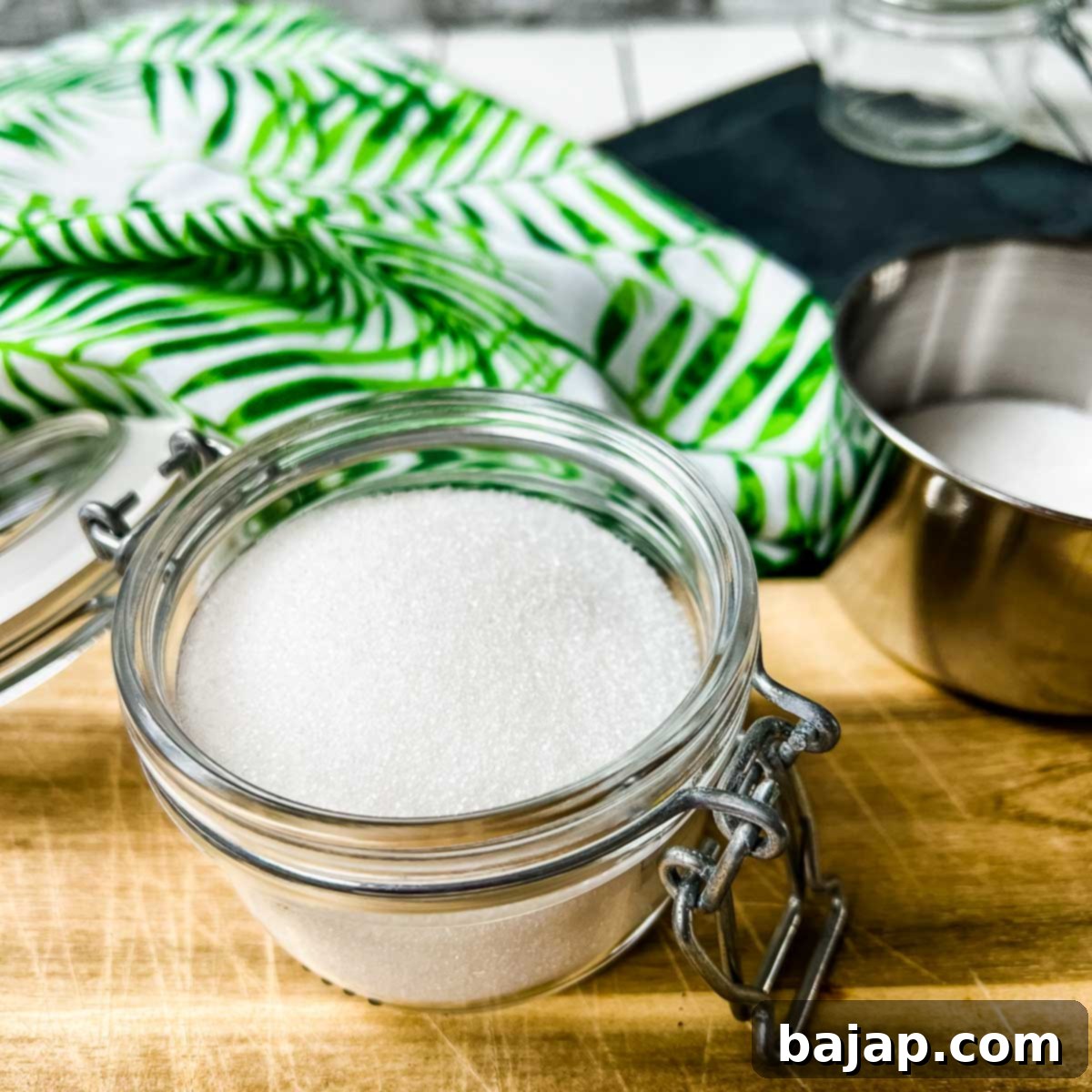The Ultimate Guide to Vanilla Sugar: Homemade Recipes, Substitutes & Uses in Baking
Vanilla sugar is a beloved and essential ingredient, particularly prominent in Austrian cuisine, where it forms the aromatic foundation for countless delectable baked goods and desserts. Its distinct, warm, and inviting flavor elevates everything from simple cakes to elaborate pastries, making it a staple in many pantries.
But what happens when you’re in the middle of a recipe and realize your vanilla sugar supply has run out? Or perhaps you’re keen to explore the joys of crafting your own, ensuring a fresh, potent supply on hand? This comprehensive guide will answer all your questions, from understanding its essence to mastering the art of homemade vanilla sugar and discovering clever substitutes.
Join us on a delightful journey into the aromatic world of vanilla and vanilla sugar. We’ll uncover what sets it apart from regular sugar, explore various methods for making it yourself, delve into the nuances between natural vanilla and synthetic vanillin, and provide practical solutions for when you need a quick alternative. Prepare to become a true vanilla connoisseur and maker right from your home kitchen!
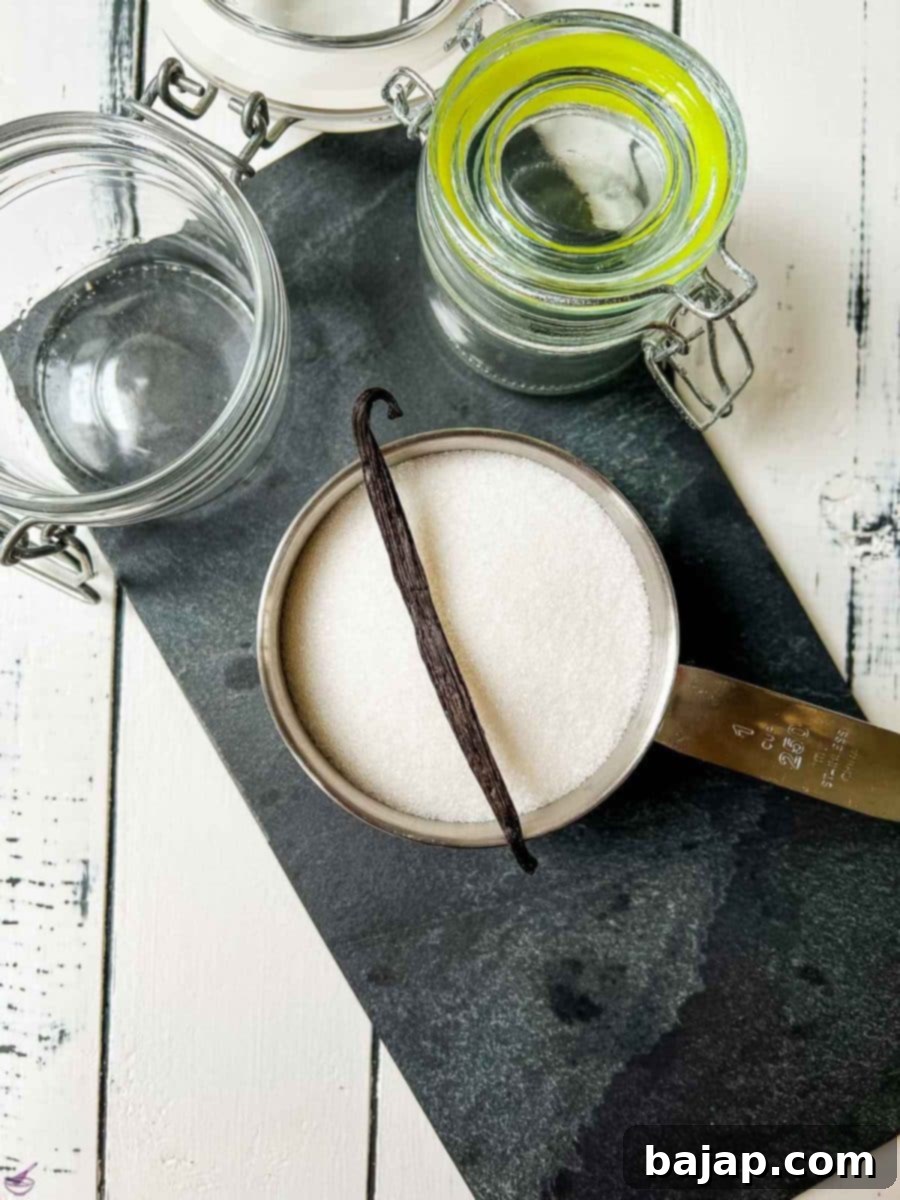
Before we dive into the details, if you’re looking for inspiring recipes that beautifully showcase vanilla sugar, explore some of our favorites:
- Our delightful potato flour cake with eggnog
- The classic Austrian strawberry sponge cake
- The incredibly moist whipped cream bundt cake
🤨 What Exactly is Vanilla Sugar?
At its core, vanilla sugar is a simple yet transformative ingredient. By definition, vanilla sugar is essentially granulated sugar that has been flavored with vanilla. This flavoring can come from natural vanilla (such as whole vanilla beans or ground vanilla powder) or from vanillin, the primary chemical compound responsible for vanilla’s characteristic aroma and flavor.
The key distinction between regular granulated sugar and vanilla sugar lies solely in this aromatic infusion. While regular sugar provides sweetness and texture, vanilla sugar delivers an additional layer of complexity and fragrance that is indispensable in many culinary traditions. It’s not just sugar; it’s sugar imbued with a sweet, woody, and floral aroma that can elevate any dish.
Traditionally, white granulated sugar forms the base for vanilla sugar. This fine-grained, loose, and crystalline substance, derived primarily from sugar beets or sugar cane, acts as a perfect canvas for the vanilla flavor. The process of infusing vanilla into sugar allows the sugar crystals to absorb and hold onto the delicate aromatic compounds, releasing them slowly when used in baking or beverages.
Vanilla sugar is a cornerstone in Austrian and European baking, frequently specified in recipes for cakes, cookies, custards, and whipped cream. Its consistent flavor profile and ease of use make it a preferred choice over vanilla extract in many traditional preparations, as it adds both sweetness and fragrance without introducing additional liquid.
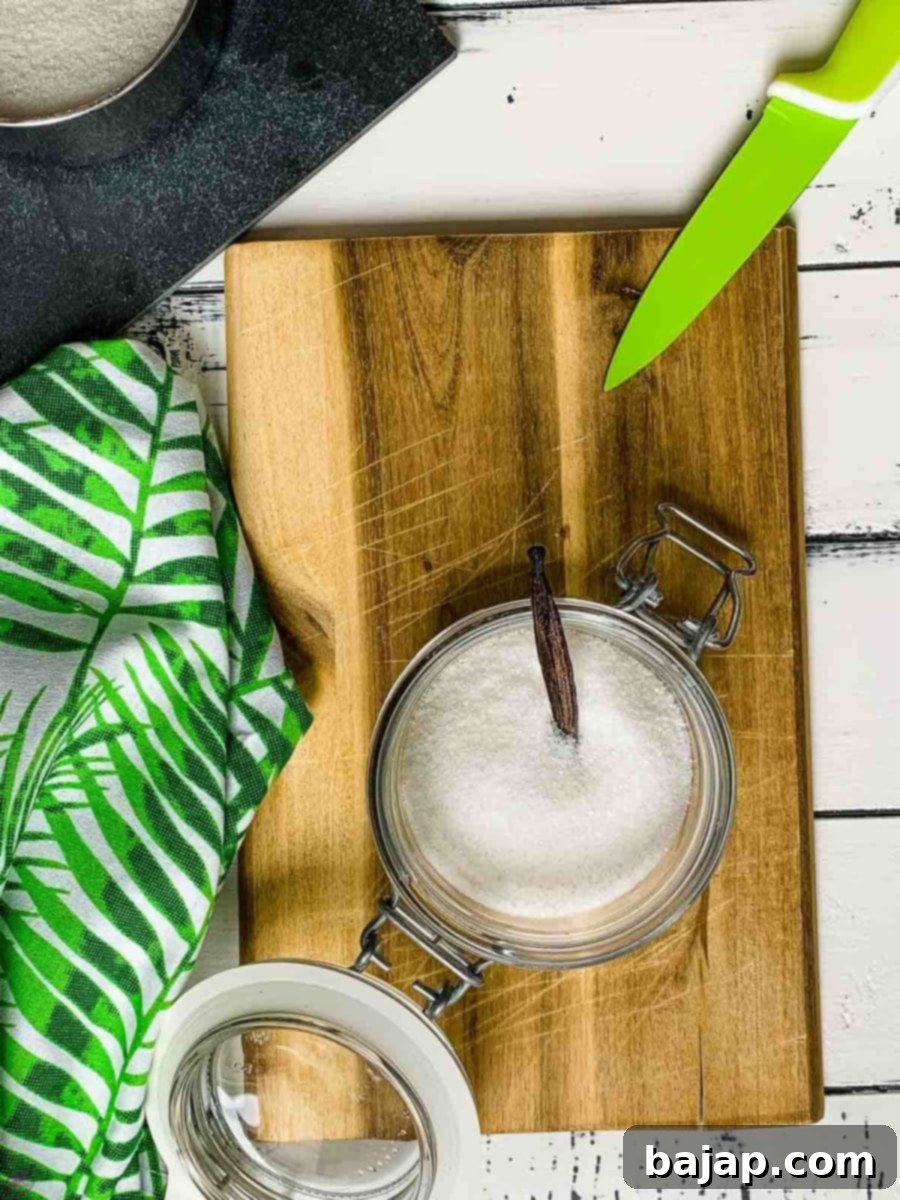
📖 The Art of Making Your Own Homemade Vanilla Sugar
Creating your own vanilla sugar at home is surprisingly simple, incredibly rewarding, and often more cost-effective than buying pre-packaged versions. Plus, homemade vanilla sugar usually boasts a much richer and more authentic flavor, as you control the quality and quantity of vanilla used. There are a few primary methods, each offering distinct advantages.
Method 1: Vanilla Bean Infusion (The Classic Way)
This is arguably the most traditional and preferred method for crafting vanilla sugar. It involves directly infusing whole vanilla beans into granulated sugar over time. The process is straightforward:
- Preparation: Start with high-quality vanilla beans. Bourbon (from Madagascar/Reunion) or Mexican vanilla beans are excellent choices due to their rich, classic vanilla flavor. Slit the vanilla beans lengthwise, exposing the fragrant seeds, but don’t scrape them out yet.
- Combining: Place the slit vanilla beans into an airtight jar. Add about 2 cups (approximately 400g) of granulated white sugar or even brown sugar for a deeper, caramel-like note. You can also bury the scraped-out seeds directly into the sugar for an immediate burst of flavor, then add the empty pods.
- Infusion: Seal the jar tightly and shake it gently to distribute the beans and sugar. Store the jar in a cool, dark place for at least two weeks, or ideally, several weeks for maximum flavor development. Shake the jar periodically to redistribute the sugar and beans, allowing the aroma to permeate evenly.
- Replenishing: As you use the vanilla sugar, you can simply top up the jar with more granulated sugar. The vanilla beans will continue to infuse new sugar for months, sometimes even over a year, gradually losing their potency. Once the beans lose their aroma, you can replace them or use them to make vanilla extract. This method yields the “vanilla sugar with dark spots” that many connoisseurs adore.
Method 2: Using Ground Vanilla (Vanilla Powder)
For a quicker infusion and a beautiful flecked appearance, using ground vanilla beans (vanilla powder) is an excellent alternative. This method immediately imparts vanilla flavor and results in sugar speckled with dark vanilla seeds, often labeled as “bourbon vanilla sugar” when store-bought.
- Preparation: Combine fine ground vanilla powder with granulated sugar in a clean, airtight container. A good starting ratio is 1 teaspoon of vanilla powder for every cup of sugar, but you can adjust this to your taste.
- Mixing: Stir or shake vigorously to ensure the vanilla powder is evenly distributed throughout the sugar.
- Usage: This vanilla sugar is ready to use almost immediately, though the flavor will deepen if allowed to sit for a few days.
Method 3: Using Vanillin (A Cost-Effective Alternative)
If you’re looking for a more economical approach or require vanilla sugar instantly without the waiting time of bean infusion, vanillin powder can be used. Vanillin is the primary flavor component of vanilla and is available in synthetic or natural forms.
- Combining: Mix a small amount of vanillin powder with granulated sugar. A tiny pinch (e.g., ⅛ to ¼ teaspoon) per cup of sugar is usually sufficient, as vanillin is quite potent.
- Mixing: Ensure thorough mixing to evenly distribute the vanillin.
- Immediate Use: This vanilla sugar is ready for immediate use. While it provides the characteristic vanilla flavor, it often lacks the complex, nuanced notes found in sugar infused with whole vanilla beans.
You can find more detailed instructions and specific ratios in our dedicated guide: Three ways to make vanilla sugar at home.
🤷♀️ Vanilla vs. Vanillin: Understanding the Key Differences
While often used interchangeably in common parlance, “vanilla” and “vanillin” refer to distinct things. Understanding this difference is crucial for appreciating the nuances of flavor and making informed choices in your cooking and baking.
Vanilla
Vanilla refers to the spice derived from the pods of orchids belonging to the genus Vanilla. Originating from Mesoamerica, the name “vanilla” comes from the Spanish “vainilla,” meaning “little pod.” The plant produces greenish-yellow flowers that yield these prized seed pods, from which the spice is made.
Commercially, the most well-known types of vanilla are:
- Bourbon Vanilla: Predominantly from Madagascar and Reunion (formerly Île Bourbon), known for its classic, rich, sweet, and creamy flavor profile.
- Mexican Vanilla: Offers a smooth, smoky, and spicy aroma, often considered the original vanilla.
- Tahitian Vanilla: Distinct for its more floral, fruity, and cherry-like notes, with lower vanillin content but a broader range of aromatic compounds.
Source: Wikipedia
When you see “vanilla” listed as an ingredient, it implies the use of the actual spice, whether in bean, extract, or ground form. To ensure you’re getting the pure, complex flavor of real vanilla, always check the ingredient list. Unfortunately, many products advertised with “real vanilla” can still contain additional artificial flavors that significantly contribute to the taste, potentially masking the true vanilla profile.
Vanillin
Vanillin is the primary phenolic aldehyde and organic compound that gives vanilla its characteristic aroma and flavor. While it is naturally present in vanilla beans, vanillin can also be produced artificially or derived from other natural sources that are not vanilla beans. This distinction is important for both cost and flavor profile.
- Artificial Vanillin: Most commonly, vanillin is produced synthetically from petrochemicals. It is significantly cheaper to produce than extracting it from vanilla beans, making it a ubiquitous flavoring agent in the food industry.
- Natural Flavoring Vanillin: Vanillin can also be derived from natural sources other than the vanilla plant itself. For example, it can be produced through the fermentation of sugar beet pulp, rice bran, or even clove oil, utilizing microorganisms. If an ingredient list states “natural flavoring vanillin,” it indicates that the vanillin was extracted from a natural source, though not necessarily a vanilla bean.
While vanillin provides the core vanilla taste, it lacks the hundreds of other aromatic compounds found in a real vanilla bean, which contribute to vanilla’s depth, complexity, and subtle nuances. Therefore, real vanilla offers a much richer and more multi-layered flavor experience compared to pure vanillin.
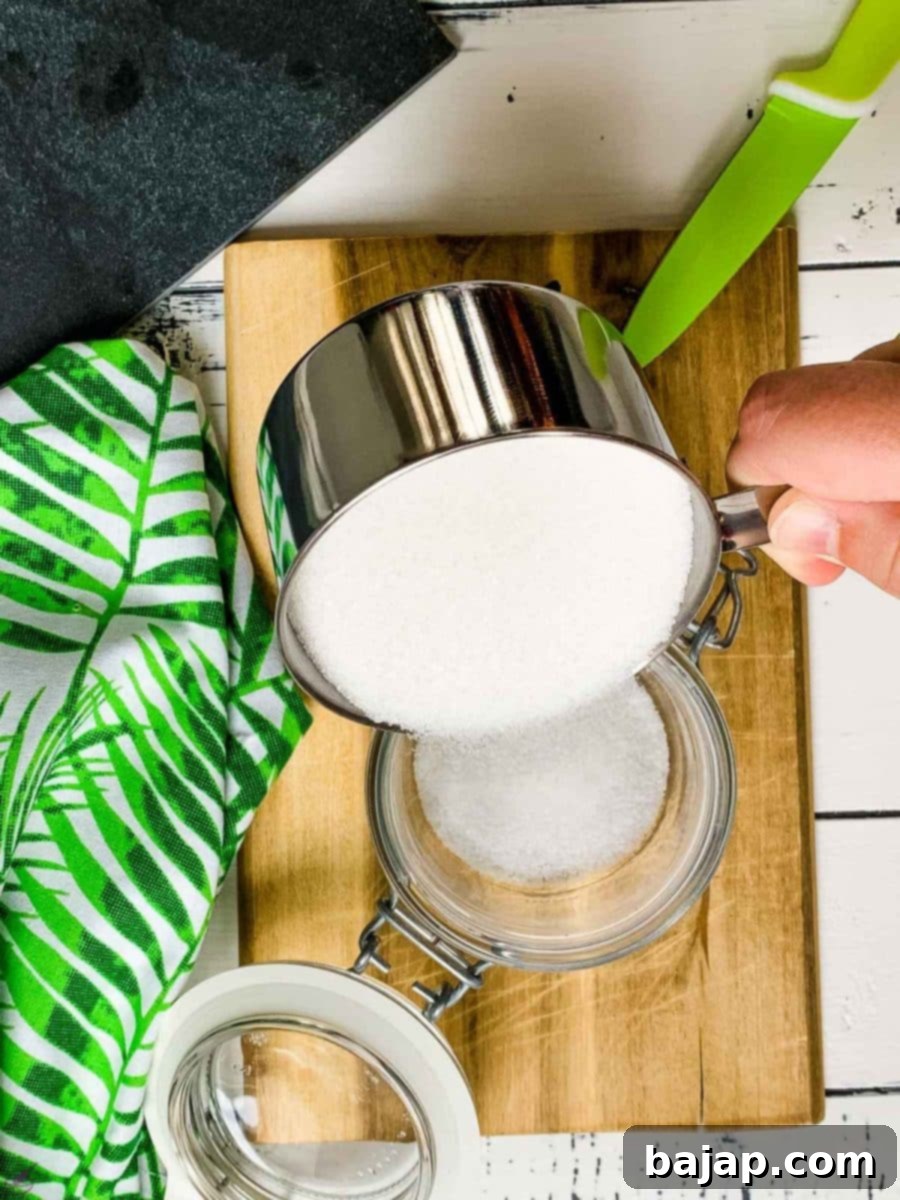
🍨 Smart Substitutes for Vanilla Sugar
Running out of vanilla sugar doesn’t have to halt your baking plans. Several excellent substitutes can provide a similar aromatic sweetness, ensuring your recipes turn out just as delicious.
- Vanilla Extract: This is arguably the most common and versatile substitute. Made by steeping vanilla beans in alcohol, vanilla extract provides concentrated vanilla flavor.
- How to use: For every packet (typically 8-10g or about 2 teaspoons) of vanilla sugar called for, use 1 to 2 teaspoons of vanilla extract and reduce the regular sugar in your recipe by 1 to 2 teaspoons (to account for the sweetness the vanilla sugar would have provided). Since extract is a liquid, be mindful of recipes where liquid balance is critical. For most baked goods, this small amount won’t make a significant difference.
- Flavor profile: Delivers a strong, authentic vanilla flavor, but without the granular texture.
- Vanilla Paste: A thick, viscous paste made from vanilla extract and ground vanilla bean seeds, often with a natural sweetener. It offers a more intense flavor than extract and the visible specks of vanilla bean for an aesthetic touch.
- How to use: Use 1 teaspoon of vanilla paste for every packet of vanilla sugar or to taste. Again, slightly reduce the amount of other sugar if the recipe is very precise.
- Flavor profile: Very similar to using real vanilla beans, offering a rich and complex aroma. It’s also easy to make yourself by simmering vanilla beans with sugar and a little water until thickened.
- Vanilla Syrup: While often associated with coffee or cocktails, vanilla syrup can be a handy substitute, especially for desserts or drinks. It’s essentially vanilla-infused sugar in liquid form.
- How to use: Replace vanilla sugar with an equal amount of vanilla syrup, then reduce other liquids in the recipe to maintain consistency. Alternatively, use a smaller amount (e.g., 1-2 teaspoons) for flavor and adjust other sugars to maintain sweetness.
- Flavor profile: Provides a pleasant vanilla aroma and sweetness. Its liquid form makes it excellent for refining ice cream, coffee, cocoa, or glazes. Making it at home involves boiling vanilla bean pulp with water and sugar until thickened, yielding an intense, sweet vanilla flavor.
- Ground Vanilla Bean/Vanilla Powder: If you have access to pure ground vanilla beans (not vanillin), this is an excellent direct substitute. It offers the full spectrum of vanilla flavor and the signature dark flecks.
- How to use: Use about ½ to 1 teaspoon of ground vanilla powder per packet of vanilla sugar, then add the equivalent amount of plain granulated sugar to your recipe.
- Flavor profile: The most authentic flavor, equivalent to or even more potent than vanilla bean-infused sugar.
- Coconut Sugar: Derived from the sap of coconut palms, coconut sugar offers a caramel-like sweetness. While not a direct flavor match for vanilla, it can provide a pleasant alternative sweetness in some recipes.
- How to use: Substitute 1:1 for vanilla sugar.
- Flavor profile: Note that using coconut sugar means you will lose the distinct vanilla flavor that is often desired in recipes calling for vanilla sugar. It’s best used when the vanilla note isn’t paramount, or if you plan to add vanilla extract alongside it.
When choosing a substitute, consider the dominant flavors of your recipe and whether the liquid content or color changes will affect the final product.
🌱 Is Vanilla Sugar Vegan? A Closer Look
For most brands and homemade versions, vanilla sugar is indeed vegan. The primary ingredients are sugar and vanilla, both of which are plant-based. Sugar is typically derived from sugar beets or sugar cane, and vanilla comes from the vanilla orchid plant.
However, there’s an important nuance to consider regarding sugar processing:
Some refined white sugar, particularly in certain regions, is processed using “bone char” (also known as animal charcoal). This charcoal, derived from animal bones, is used as a decolorizing filter to achieve the sugar’s bright white appearance. While the bone char itself does not remain in the final sugar product, its use in the manufacturing process makes the sugar non-vegan for strict vegetarians and vegans.
To ensure your vanilla sugar is genuinely vegan, especially when purchasing store-bought varieties:
- Check the Ingredient List: Look for labels that explicitly state “vegan” or “bone char-free” sugar.
- Contact the Manufacturer: If in doubt, reaching out to the product manufacturer is the most reliable way to confirm their sugar sourcing and processing methods.
- Opt for Unrefined Sugars: To be completely safe, avoid highly refined white sugar and products containing it. Instead, choose sugars that are guaranteed vegan, such as:
- Organic Cane Sugar: Often processed without bone char.
- Unrefined Cane Sugar (e.g., Rapadura, Panela, Muscovado): These sugars retain more of their natural molasses content, giving them a darker color and a richer flavor. They are typically not processed with bone char.
- Beet Sugar: Sugar derived from sugar beets is almost always processed without bone char, making it a reliable vegan option.
Beyond being a vegan-friendly choice, whole cane sugar offers additional benefits over highly refined sugar. Since it contains molasses, with its valuable minerals and trace vitamins, it is often considered a healthier type of sugar, providing more than just empty calories.
🪴 Can You Grow Vanilla at Home?
Yes, growing your own vanilla plant (Vanilla planifolia) is entirely possible, though it presents a fascinating challenge that requires specific environmental conditions and a good deal of patience. The vanilla plant is an orchid and, like many orchids, has particular needs.
Here’s what you should know:
- Climate Requirements: Vanilla orchids thrive in very warm, humid environments, mimicking their native tropical habitats. They prefer temperatures between 70-90°F (21-32°C) and high humidity (around 80-90%). This makes growing them outdoors primarily feasible in USDA hardiness zones 10 and above, or in tropical climates.
- Indoor Cultivation: For most people, growing vanilla indoors in a greenhouse or a controlled environment is necessary. They require bright, indirect light and a well-draining, airy potting medium, often a mix of orchid bark, sphagnum moss, and perlite. Regular misting or a humidity tray is essential.
- Pollination: One of the biggest challenges is pollination. In their natural habitat, vanilla orchids are pollinated by specific bee species (Melipona bees) for only a few hours on the day the flower opens. When grown outside these native regions, hand-pollination is required, which is a delicate process demanding precision and timing.
- Patience for Pods: Even with successful pollination, it can take several years (typically 3-5 years) for a vanilla plant to mature enough to produce flowers, and then another 6-9 months for the pods to develop and ripen after successful pollination.
Despite the challenges, the reward of harvesting your own vanilla beans is immense. It’s a journey into botanical artistry and a testament to patience. If you’re intrigued by the idea and ready to learn and practice the art of vanilla cultivation, you might find this article helpful:
How to Plant Vanilla?
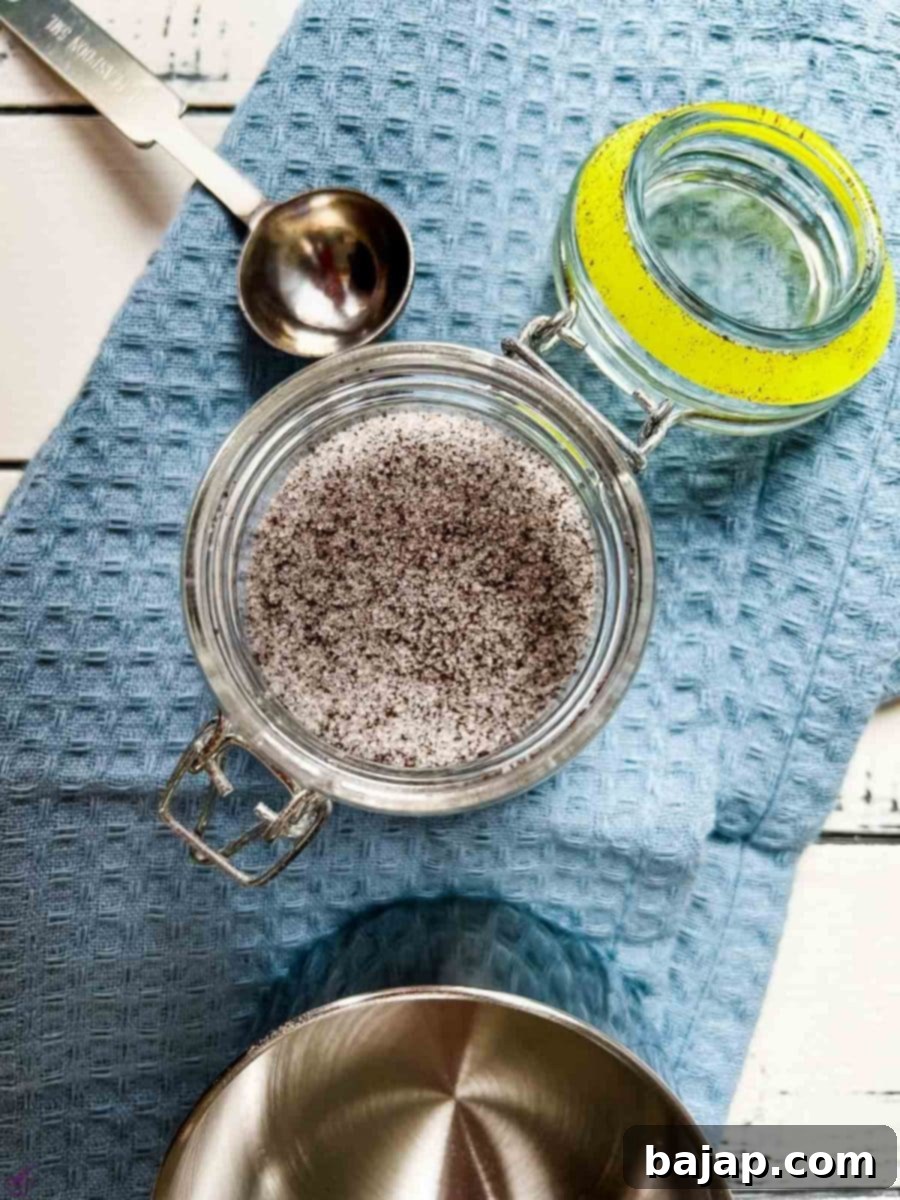
Storage and Shelf Life of Vanilla Sugar
Once you’ve made your delicious homemade vanilla sugar, proper storage is key to preserving its exquisite aroma and flavor for as long as possible. Whether store-bought or homemade, vanilla sugar benefits from specific storage conditions.
- Airtight Container: Always store vanilla sugar in a tightly sealed, airtight container. This prevents moisture from getting in, which can cause clumping, and also stops the delicate vanilla aroma from dissipating.
- Cool, Dark Place: Keep the container in a cool, dark pantry or cupboard, away from direct sunlight, heat, and strong odors. Light and heat can degrade the vanilla compounds, diminishing the flavor.
- Replenishing Vanilla Beans: If you’re using whole vanilla beans to infuse your sugar, remember that the beans will continue to release their flavor over time. As you use the sugar, you can simply replenish the jar with more granulated sugar. Over many months, the vanilla beans will gradually lose their potency. You can then replace them with fresh beans or use the spent beans to make vanilla extract or vanilla bean paste, extracting every last drop of flavor.
- Shelf Life: Homemade vanilla sugar, especially with whole beans, can last for many months, even up to a year or more, maintaining excellent flavor. Store-bought vanilla sugar typically has a longer shelf life due to preservatives, but its flavor may be less intense.
Frequently Asked Questions About Vanilla Sugar
Here are answers to some common questions about vanilla sugar, helping you master this versatile ingredient.
- How much vanilla sugar equals a packet?
- A standard packet of vanilla sugar in European recipes typically contains 8 to 10 grams (about 0.3 to 0.35 ounces), which is roughly equivalent to 1 to 2 teaspoons of vanilla extract or homemade vanilla sugar.
- Can I use vanilla extract instead of vanilla sugar?
- Yes, absolutely! Vanilla extract is one of the best substitutes. Use 1-2 teaspoons of vanilla extract for every packet of vanilla sugar called for, and reduce other sugars in the recipe slightly to compensate for the lost sweetness.
- What type of vanilla bean is best for making vanilla sugar?
- Bourbon vanilla beans (from Madagascar or Reunion) are generally considered the best for their classic, rich, and creamy vanilla flavor profile. Mexican vanilla beans also work wonderfully, offering a smooth, slightly smoky note.
- Does vanilla sugar go bad?
- While vanilla sugar itself doesn’t typically “go bad” in the traditional sense, its flavor can diminish over time. Properly stored in an airtight container, it can retain its aroma for many months, even a year or more, especially if infused with whole vanilla beans. Ensure no moisture gets in to prevent clumping or mold.
- Can I use brown sugar to make vanilla sugar?
- Yes, you can! Using brown sugar creates a vanilla sugar with a deeper, more caramel-like flavor and a beautiful brownish hue. The process is the same as with white granulated sugar.
🍨 Explore More Vanilla-Inspired Delights
If you’ve enjoyed learning about vanilla sugar, you’ll love these other recipes and articles that celebrate the rich, aromatic goodness of vanilla and delightful baked treats.
- Homemade Vanilla Ice Cream Recipe
- Viennese Sponge Cake Bases Recipe
- How to bake cookies from leftover egg yolks
- Vanilla Bean Ice Cream Pancakes {Palatschinken}
